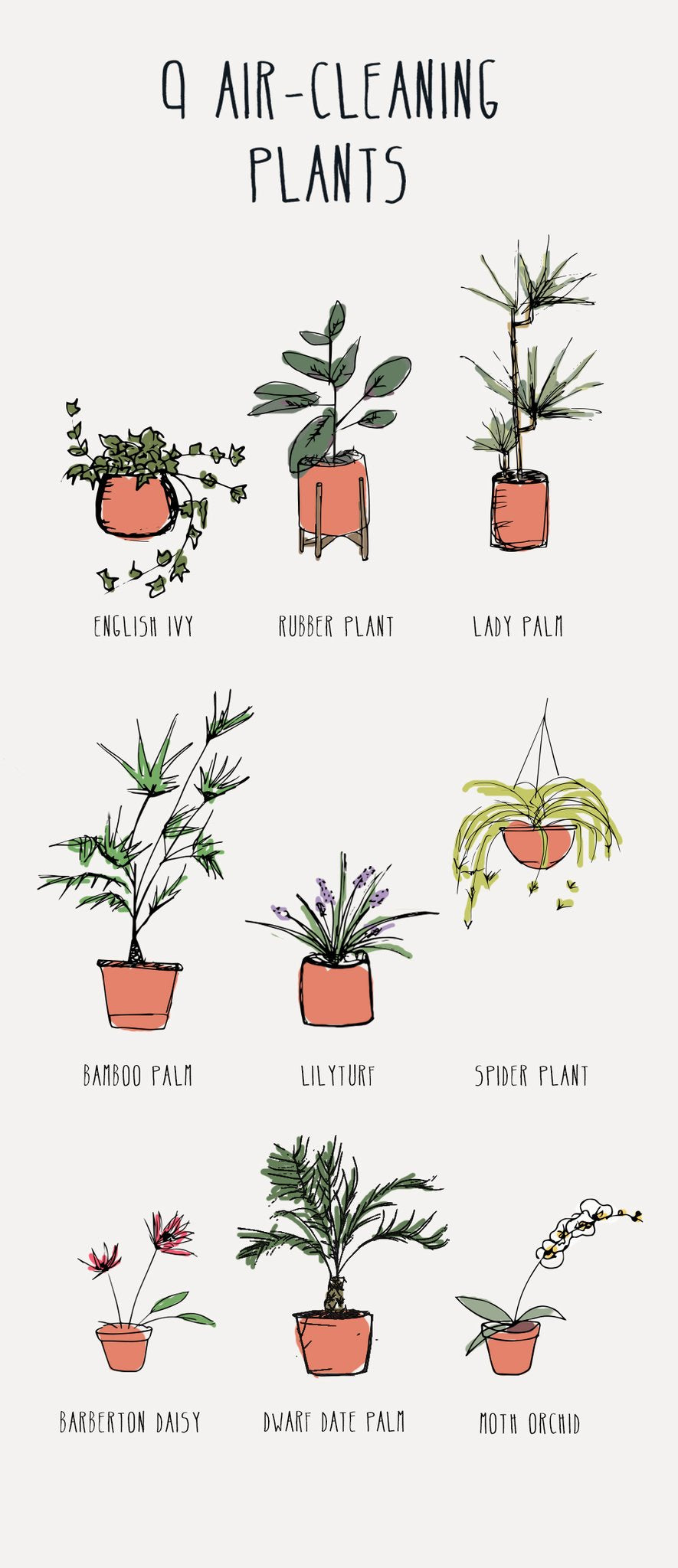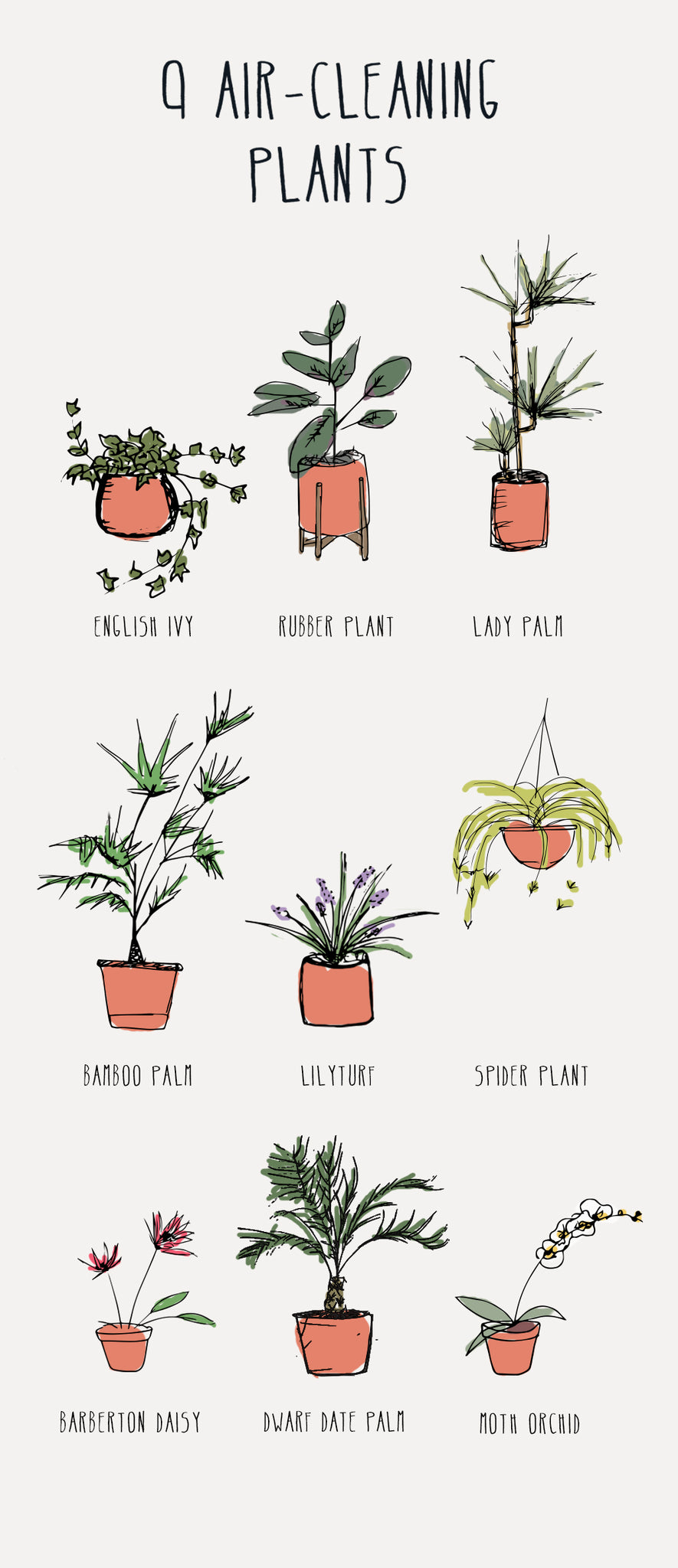
9 Best Air-Cleaning Plants
 WRITTEN BY NIKKI ROXBY
WRITTEN BY NIKKI ROXBY
We just moved recently and I was amazed and overwhelmed by how many toxins we were exposed to in our new home. I tried air purifiers throughout our home, but they did not seem to help much. I did some research and found that in 1989 NASA published the Clean Air study in an attempt to find the best ways to purify the air in space stations. It turns out that synthetic materials found in both space stations and our homes let off low levels of volatile organic compounds (VOCs). These chemicals are known irritants and also potential carcinogens. This process is called off-gassing and can cause people living in a closed off space with these compounds to become ill.
The NASA study showed a series of air-filtering plants that in addition to absorbing carbon dioxide and releasing oxygen back into the air, also eliminate VOCs found in most homes. The plants pull toxic compounds from the air down around the plant’s roots, where it is converted into food for the plant. The study recommends one houseplant per 100 square feet and a variety of houseplants that remove different types of chemicals in order to most efficiently clean the air.
Tip:
With so much time spent at school, an air filtering plant for your child’s classroom would make a perfect “class warming” gift at the beginning of the school year or any time of the year to help ensure they are protected with clean air even when they are not with you.
Here is a list of plant options that are non-toxic to dogs and children and what they help to remove.
1. English Ivy
Benefits: Great with pets. Removes fecal matter, formaldehyde, and chemical benzene, a known carcinogen found in cigarette smoke, detergents, pesticides, and the off-gassing of other synthetic materials. English ivy is also said to be fantastic for asthmas and allergies.
Care: This plant can be invasive! For this reason, we recommend putting this plant in a pot.
2. Rubber plant
Benefits: Purifies indoor air by removing chemicals like formaldehyde and other toxins. These houseplants clean the air by emitting high oxygen content.
Care: Likes filtered light, infrequent watering & rich soil.
3. Broadleaf lady palm
Benefits: Great overall air purifier. Removes formaldehyde, xylene, toluene, ammonia, and most air pollutants.
Care: Prefers indirect sunlight, and watering without fertilizers.
4. Bamboo Palm
Benefits: Removes formaldehyde, xylene, and toluene. It is also said to act as a natural humidifier.
Care: Likes bright, indirect light and prefers to remain moist but not too much and doesn't like sitting in water.
5. Lilyturf
Benefits: Removes formaldehyde, xylene, toluene, and ammonia
6. Spider Plant
Benefits: Within two days, can eliminate up to 90 percent of indoor toxins. NASA places this plant among the top 3 types of houseplants that are great at removing formaldehyde. Also, removes carbon monoxide and other toxins or impurities.
Care: Likes bright, indirect light and lots of water while growing.
7. Barberton daisy
Benefits: Removes benzene, Formaldehyde, xylene, and toluene. It also absorbs carbon dioxide and gives off oxygen overnight, which is said to improve your sleep.
Care: Likes bright light.
8. Dwarf date palm
Benefits: Removes Formaldehyde, xylene, (a chemical found in plastics and solvents) and toluene from the air.
Care: Loves lots of sun, moist soil, and warm water.
9. Moth orchids
Benefits: Removes xylene, toluene, and formaldehyde commonly off-gassed from paints, solvents, and other synthetic materials.
Care: Thrives in high humidity, lots of light (but not hot, mid-day sun) and thorough waterings with complete drying out between waterings.
+ 2 more...
10. Kimberly queen fern
Benefits: Clean formaldehyde, xylene, and toluene out of your home.
Care: Prefers bright, but indirect sunlight, with dry soil between waterings.
11. Chrysanthemum
Benefits: Removes benzene, a carcinogen associated with most chemicals, plastics, cigarettes, and off-gassing. Also removes trichloroethylene (found in solvents and cleaners), formaldehyde and ammonia.
Care: Likes partial sun, and lots of water. Keep in mind they only flower once, annually.
Sources:
http://www.ncbi.nlm.nih.gov/
http://www.freebase.com/m/
http://ntrs.nasa.gov/archive/
https://en.wikipedia.org/wiki/
http://www.sustainablebabysteps.com/types-of-houseplants.html





 WRITTEN BY NIKKI ROXBY
WRITTEN BY NIKKI ROXBY

4 comments
Is philodendron as good at cleaning the air as english ivy?
Linda
English ivy is toxic to dogs, cats and horses according to the Pet Poison Hotline, ASPCA and several veterinarians. Just thought you should know.
Jen
Not a comment but a question. This article sites English Ivy as “removing fecal matter”. Is there a process we can use for this or should I assume it to mean that it removes pet odor.?
Susan
Thank you for this article. I needed ideas and some knowledge of indoors plants that benefit the air.
Claire Riding
Leave a comment
This site is protected by hCaptcha and the hCaptcha Privacy Policy and Terms of Service apply.